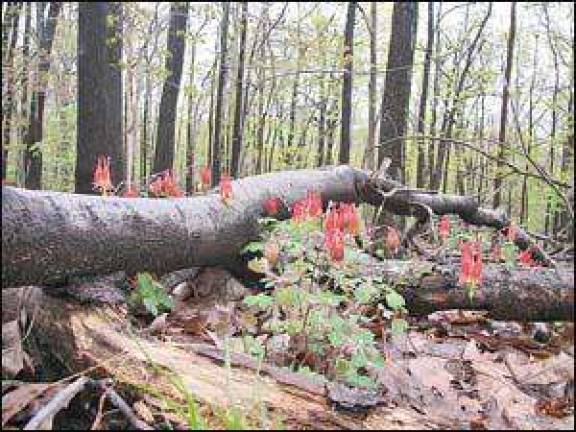Study documents Trout Brook's natural wonders

Hudsonia helps property owners and local governments head off environmental problems, By Edie Johnson Monroe While some of us took refuge in air-conditioned rooms, biologists from Hudsonia spent last summer exploring the woods, hills, valleys, rocky ledges and rushing riverbeds of the Trout Brook watershed. Surprises along the way included some rare finds, such as timber rattlesnakes and forest-breeding birds like the scarlet tanager. And they came across a few black bears. The biologists from Hudsonia, a nonprofit environmental research group, reported every species they found. They also produced a giant overlay map showing every parcel in the 6.5-mile watershed, which extends through Chester, Monroe, Warwick, Sterling Forest, and Tuxedo. The report describes the quality of each habitat and lists species of special concern. Andrew Meyer, a Hudsonia biologist, recently reported the team’s findings to an audience at Chester town hall. He described 22 types of habitat and the animals and plants that rely on them. He described the importance of each kind of habitat as though lives depended on it and they do. Intermittent pools, he said, are perfect for amphibians like frogs in an environment without predators. Rocky outcrops are ideal for timber rattlesnakes, who come out of their dens to lie on the sun-warmed stone in preparation for breeding. Grasslands in North America support at least 70 bird species, some of whom breed in nests on the ground deep in the tall grass. Birds require at least 100 acres of grassland to meet their needs. The northern harrier, which may nest through mid-September, is particularly vulnerable to large mowing machines. Local residents can help increase their numbers simply by postponing mowing. The Trout Brook watershed still has large spans of contiguous forest, a high-priority resource that enables wildlife to travel from one area to another. Meyer said unbroken forest is essential for the many species that spend part of the year in the lowlands and part in the uplands, and those that must migrate from one wetland to another to survive. The watershed is especially important because it connects three major tracts of forest: the Highlands, Goosepond Mountain State Park, and Sterling Forest. Toward smarter development Hudsonia is not anti-development, Meyer said. Rather, it offers developers and municipalities designs that work the best in any given environment. “The best time to address environmental concerns is at the outset, beginning with the siting and design of a development,” he said. Hudsonia is not just for scientific study but is interested in economic solutions, he said. The habitat overlay maps will allow ecological conditions to be considered at the outset of a project. The study goes beyond plants and animals to consider how nature and infrastructure work or don’t work together. It documents 85 culverts and seven dams, and suggests areas where obstructions may be contributing to flooding. Meyer said natural drainage systems should be allowed to do their work. Funneling run-off directly into streams, rather than letting water percolate through the earth to the aquifer below, disrupts aquatic life by changing the water temperature. Hudsonia and other organizations can restore natural vegetation along streams to provide this added level of filtration, Meyer said. Hudsonia used the U.S. Geological Survey to help spread the word. Much of the data on the first five towns studied has been superimposed on GoogleEarth maps. Infrared stereoscopic photographs from the Geological Survey make every detail clear. Hudsonia’s Web site (www.hudsonia.org) provides links to GoogleEarth maps and habitat types. A search will reveal which plants and animals are at risk in the habitats studied backyard, circumneutral bog lake, cool ravine, crest, ledge, talus, fen, intermittent woodland pool, marble knoll, meadow, red cedar woodland, stream, swamp, and upland forest. Follow the link farther, and find information about the species at risk. The Hudsonia team included Nava Tabak, Kristen Bell Travis, and Gretchen Stevens. A legal settlement with a corporation that violated New York State Department of Environmental Conservation rules provided the funding for the study. To see the map, please visit www.thephoto-news.com. Hudsonia is supported by charitable resources and state agencies, and is based at Bard College in Red Hook. Its biologists are ready and eager to help everyone involved in land planning, including property owners, developers, and municipal officials.